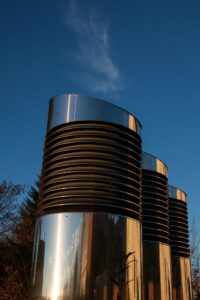Does your facility need an industrial exhaust system?
That’s actually a bit of a trick question. Practically every building needs some method of exhaust to remove stale, dirty air from building interiors. Air quality deteriorates without proper exhaust, which can cause a huge number of health and safety hazards. A building exhaust system helps reduce this risk by helping remove low quality air from the indoor environment. In this article, we’ll discuss how exhaust in industrial facilities works and what you need for an effective exhaust system.
How Does an Industrial Exhaust System Work?
At the most basic level, exhaust is removing air from a building. You might want to remove air because it’s too hot, too humid, or contains contaminants. Some contaminants that might be in the air include:
- Dust
- Pathogens/Molds
- Gases
- Debris
Most industrial ventilation systems contain some type of exhaust system to help replace old, low-quality air with fresh, high quality air.

In a well designed ventilation system, exhaust locations are near areas where contaminated air typically accumulates. The system then takes that air and removes it from the building. This creates a pressure differential between the inside of your building and outside. Outdoor air then floods in to replace the air that escapes through the exhaust system.
You can achieve this in several ways, including through natural ventilation processes, but the most common way today is to use mechanical equipment to aid exhaust processes.
What Type of Equipment is Needed for Exhaust Ventilation?
A mechanical industrial exhaust system relies on mechanical equipment to aid in exhausting contaminated air. The type of equipment depends on your specific facility and applications, as exhaust ventilation is completely customizable and can be different for each building.
Typically, the system will start with fans to help force contaminated air out of the indoor environment. For general ventilation such as removing hot, humid air for occupant comfort, the system usually expels it directly outside. However, if you’re exhausting air with certain contaminants, there may be regulations against releasing them into the environment. If this is the case, then the exhaust system may include specialized filters to help trap the contaminants so you can dispose of them properly at a later time.
Once the old air is exhausted, new supply air comes in to take its place. Many exhaust systems use powered supply equipment to help push in new air as old air is exhausted. However, you can pair mechanical exhaust with natural supply air solutions like wall louvers. Your ventilation specialist can help give you more specific recommendations after an evaluation of your building and a consultation about your needs and goals.
Expert Industrial Ventilation Control and Systems from Eldridge
Need to improve your facility’s ventilation? Work with our specialists at Eldridge! We’ve been creating successful environments for people, products, and processes since 1946! Our team of experts utilize state-of-the-art tools and software to design the ideal Industrial ventilation system for your needs. We also work with top equipment manufacturers to provide high quality, long-lasting systems for your building. Contact us now for a free industrial ventilation quote and consultation!
